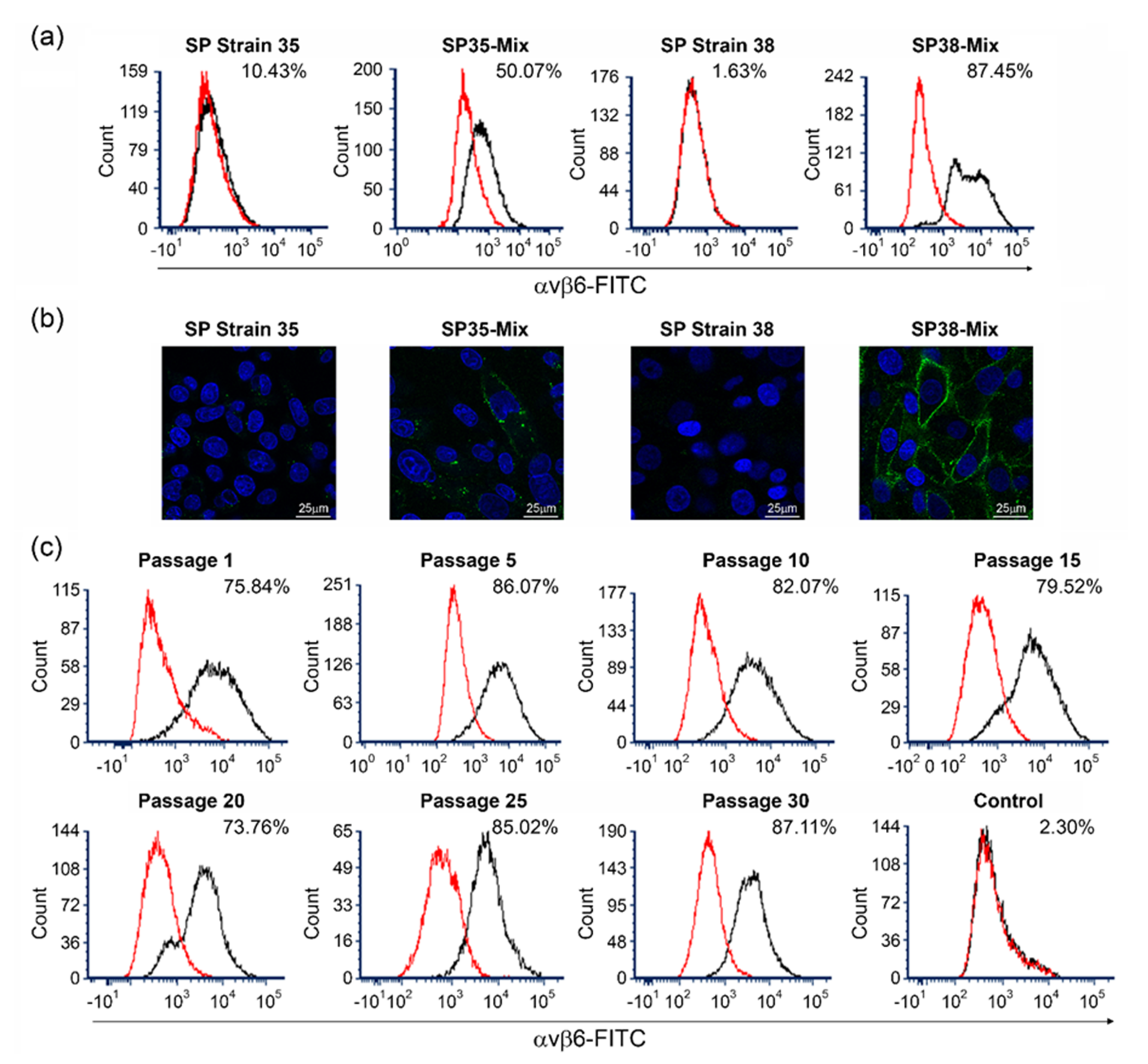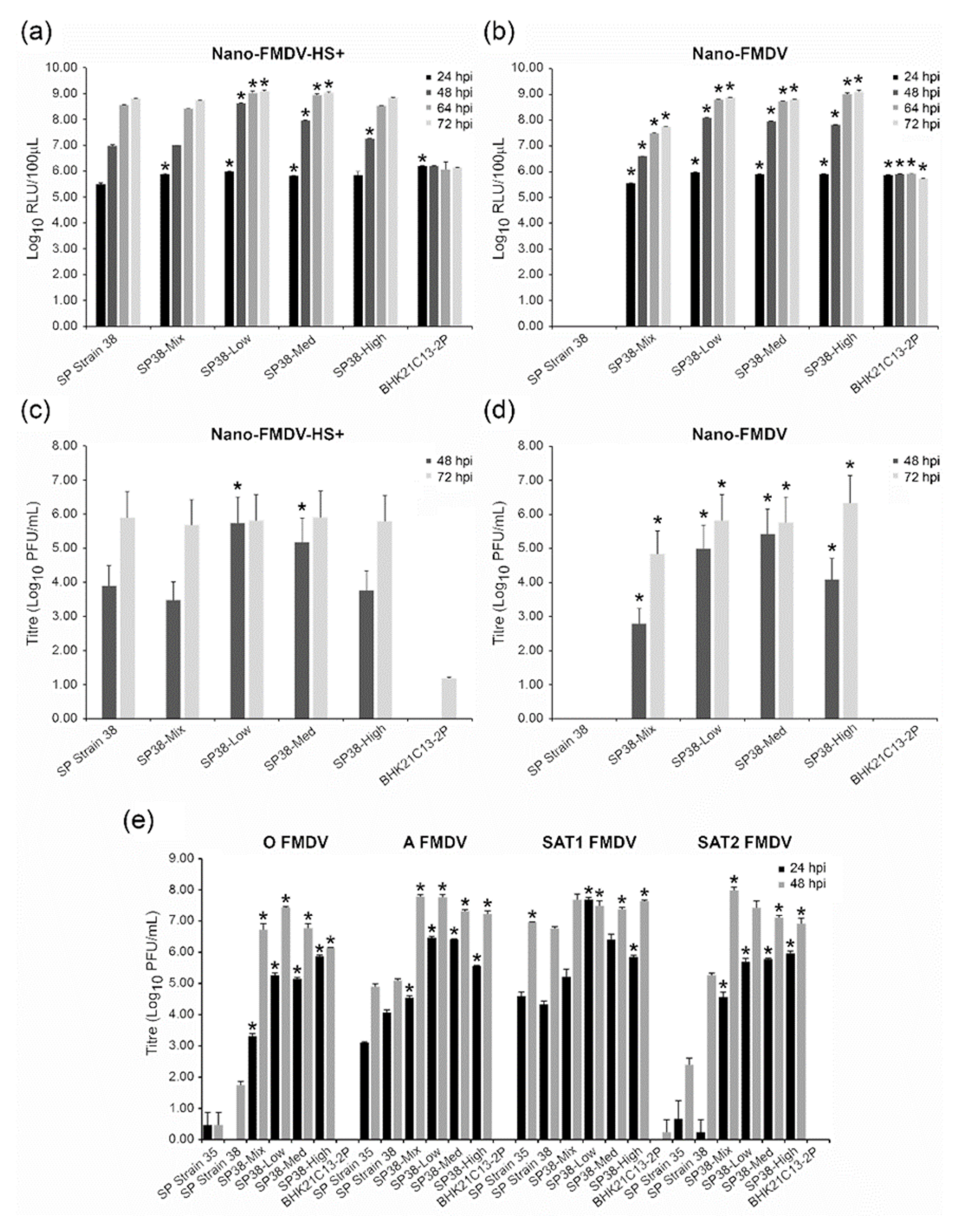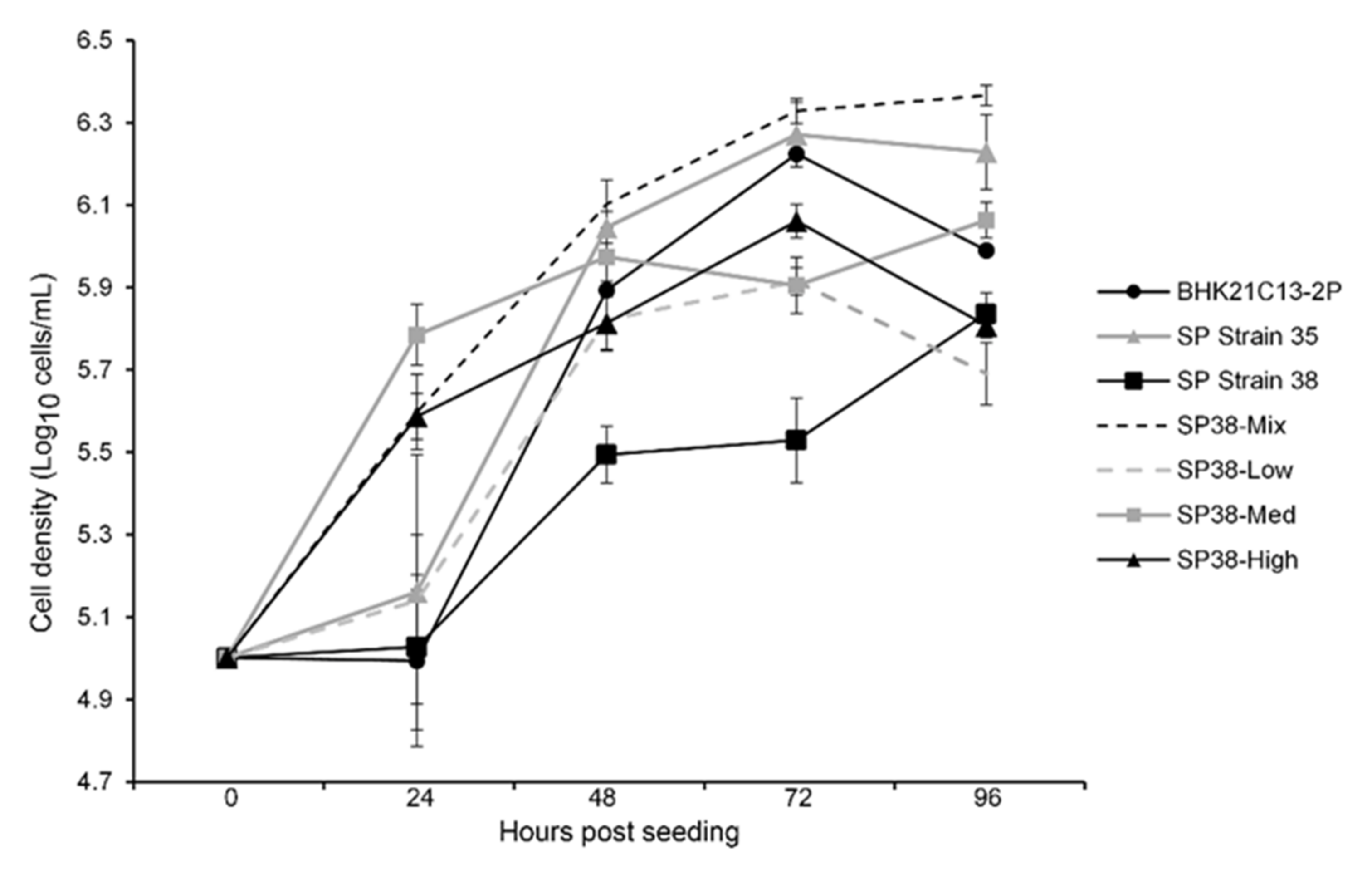An Improved αvβ6-Receptor-Expressing Suspension Cell Line for Foot-and-Mouth Disease Vaccine Production
Abstract
:1. Introduction
2. Materials and Methods
2.1. Cell Lines
2.2. Construction of αvβ6 Integrin Expression Plasmids and Transfection of Cells
2.3. Characterisation of Cell-Surface Expression of Integrin Heterodimers by Flow Cytometry
2.4. Immunofluorescence Microscopy
2.5. FMDV Strains
2.6. Plaque Assays
2.7. Virus Neutralisation Test
2.8. Luciferase Assays
2.9. Statistical Analyses
3. Results
3.1. Adaptation of BHK-21 to Suspension Culture and Effect on FMDV Receptor Expression
3.2. Generation of Recombinant Suspension BHK-21 Expressing αvβ6 Integrin
3.3. Evaluation of Suspension BHK-21 Expressing αvβ6 Integrin to Support Non-Cell Culture Adapted FMDV
3.4. Comparative Growth Analysis of Suspension BHK-21 Expressing αvβ6 Integrin
3.5. Additional Applications of SP38-Mix: Virus Neutralisation Test and Detection of Cytopathic Effect
4. Discussion
Supplementary Materials
Author Contributions
Funding
Institutional Review Board Statement
Informed Consent Statement
Acknowledgments
Conflicts of Interest
References
- Knight-Jones, T.J.; Rushton, J. The economic impacts of foot and mouth disease—What are they, how big are they and where do they occur? Prev. Vet. Med. 2013, 112, 161–173. [Google Scholar] [CrossRef] [PubMed] [Green Version]
- Grubman, M.J.; Baxt, B. Foot-and-mouth disease. Clin. Microbiol. Rev. 2004, 17, 465–493. [Google Scholar] [CrossRef] [PubMed] [Green Version]
- Knowles, N.J.; Samuel, A.R. Molecular epidemiology of foot-and-mouth disease virus. Virus Res. 2003, 91, 65–80. [Google Scholar] [CrossRef]
- Jackson, T.; Clark, S.; Berryman, S.; Burman, A.; Cambier, S.; Mu, D.; Nishimura, S.; King, A.M.Q. Integrin alphavbeta8 functions as a receptor for foot-and-mouth disease virus: Role of the beta-chain cytodomain in integrin-mediated infection. J. Virol. 2004, 78, 4533–4540. [Google Scholar] [CrossRef] [Green Version]
- Jackson, T.; Mould, A.P.; Sheppard, D.; King, A.M. Integrin alphavbeta1 is a receptor for foot-and-mouth disease virus. J. Virol. 2002, 76, 935–941. [Google Scholar] [CrossRef] [Green Version]
- Neff, S.; Sá-Carvalho, D.; Rieder, E.; Mason, P.W.; Blystone, S.D.; Brown, E.J.; Baxt, B. Foot-and-mouth disease virus virulent for cattle utilizes the integrin alpha(v)beta3 as its receptor. J. Virol. 1998, 72, 3587–3594. [Google Scholar] [CrossRef] [PubMed] [Green Version]
- Jackson, T.; Sheppard, D.; Denyer, M.; Blakemore, W.; King, A.M. The epithelial integrin alphavbeta6 is a receptor for foot-and-mouth disease virus. J. Virol. 2000, 74, 4949–4956. [Google Scholar] [CrossRef]
- Sa-Carvalho, D.; Rieder, E.; Baxt, B.; Rodarte, R.; Tanuri, A.; Mason, P.W. Tissue culture adaptation of foot-and-mouth disease virus selects viruses that bind to heparin and are attenuated in cattle. J. Virol. 1997, 71, 5115–5123. [Google Scholar] [CrossRef] [Green Version]
- Jackson, T.; Ellard, F.M.; Ghazaleh, R.A.; Brookes, S.M.; Blakemore, W.E.; Corteyn, A.H.; Stuart, D.I.; Newman, J.W.; King, A.M. Efficient infection of cells in culture by type O foot-and-mouth disease virus requires binding to cell surface heparan sulfate. J. Virol. 1996, 70, 5282–5287. [Google Scholar] [CrossRef] [Green Version]
- Dill, V.; Eschbaumer, M. Cell culture propagation of foot-and-mouth disease virus: Adaptive amino acid substitutions in structural proteins and their functional implications. Virus Genes 2020, 56, 1–15. [Google Scholar] [CrossRef] [Green Version]
- Chitray, M.; Kotecha, A.; Nsamba, P.; Ren, J.; Maree, S.; Ramulongo, T.; Paul, G.; Theron, J.; Fry, E.E.; Stuart, D.I.; et al. Symmetrical arrangement of positively charged residues around the 5-fold axes of SAT type foot-and-mouth disease virus enhances cell culture of field viruses. PLoS Pathog. 2020, 16, e1008828. [Google Scholar] [CrossRef] [PubMed]
- Mohapatra, J.K.; Pandey, L.K.; Rai, D.K.; Das, B.; Rodriguez, L.L.; Rout, M.; Subramaniam, S.; Sanyal, A.; Rieder, E.; Pattnaik, B. Cell culture adaptation mutations in foot-and-mouth disease virus serotype A capsid proteins: Implications for receptor interactions. J. Gen. Virol. 2015, 96 Pt 3, 553–564. [Google Scholar] [CrossRef] [PubMed]
- Hwang, J.H.; Lee, G.; Kim, A.; Park, J.H.; Lee, M.J.; Kim, B.; Kim, S.M. A Vaccine Strain of the A/ASIA/Sea-97 Lineage of Foot-and-Mouth Disease Virus with a Single Amino Acid Substitution in the P1 Region That Is Adapted to Suspension Culture Provides High Immunogenicity. Vaccines 2021, 9, 308. [Google Scholar] [CrossRef] [PubMed]
- Dill, V.; Zimmer, A.; Beer, M.; Eschbaumer, M. Targeted Modification of the Foot-And-Mouth Disease Virus Genome for Quick Cell Culture Adaptation. Vaccines 2020, 8, 583. [Google Scholar] [CrossRef] [PubMed]
- Bolwell, C.; Brown, A.L.; Barnett, P.V.; Campbell, R.O.; Clarke, B.E.; Parry, N.R.; Ouldridge, E.J.; Brown, F.; Rowlands, D.J. Host cell selection of antigenic variants of foot-and-mouth disease virus. J. Gen. Virol. 1989, 70 Pt 1, 45–57. [Google Scholar] [CrossRef] [PubMed]
- Rieder, E.; Baxt, B.; Mason, P. Animal-derived antigenic variants of foot-and-mouth disease virus type A12 have low affinity for cells in culture. J. Virol. 1994, 68, 5296–5299. [Google Scholar] [CrossRef] [PubMed] [Green Version]
- Curry, S.; Fry, E.; Blakemore, W.; Ghazaleh, R.A.; Jackson, T.; King, A.; Lea, S.; Newman, J.; Rowlands, D.; Stuart, D. Perturbations in the surface structure of A22 Iraq foot-and-mouth disease virus accompanying coupled changes in host cell specificity and antigenicity. Structure 1996, 4, 135–145. [Google Scholar] [CrossRef] [Green Version]
- Maree, F.F.; Blignaut, B.; Aschenbrenner, L.; Burrage, T.; Rieder, E. Analysis of SAT1 type foot-and-mouth disease virus capsid proteins: Influence of receptor usage on the properties of virus particles. Virus Res. 2011, 155, 462–472. [Google Scholar] [CrossRef]
- Esmaelizad, M.; Jelokhani-Niaraki, S.; Hashemnejad, K.; Kamalzadeh, M.; Lotfi, M. Molecular characterization of amino acid deletion in VP1 (1D) protein and novel amino acid substitutions in 3D polymerase protein of foot and mouth disease virus subtype A/Iran87. J. Vet. Sci. 2011, 12, 363–371. [Google Scholar] [CrossRef]
- Cook, J.K.; Jones, B.V.; Ellis, M.M.; Jing, L.; Cavanagh, D. Antigenic differentiation of strains of turkey rhinotracheitis virus using monoclonal antibodies. Avian Pathol. 1993, 22, 257–273. [Google Scholar] [CrossRef]
- Julef, N.; Windsor, M.; Reid, E.; Seago, J.; Zhang, Z.; Monaghan, P.; Morrison, I.W.; Charleston, B. Foot-and-mouth disease virus persists in the light zone of germinal centres. PLoS ONE 2008, 3, e3434. [Google Scholar] [CrossRef] [Green Version]
- Jackson, B.; Harvey, Y.; Perez-Martin, E.; Wilsden, G.; Juleff, N.; Charleston, B.; Seago, J. The selection of naturally stable candidate foot-and-mouth disease virus vaccine strains for East Africa. Vaccine 2021, 39, 5015–5024. [Google Scholar] [CrossRef] [PubMed]
- Zhang, F.; Perez-Martin, E.; Juleff, N.; Charleston, B.; Seago, J. A replication-competent foot-and-mouth disease virus expressing a luciferase reporter. J. Virol. Methods 2017, 247, 38–44. [Google Scholar] [CrossRef] [PubMed]
- OIE. Foot-and-Mouth Disease, Manual of Diagnostic Tests and Vaccines for Terrestrial Animals: Mammals, Birds, and Bees; OIE: Paris, France, 2012. [Google Scholar]
- Kärber, G. Beitrag zur kollektiven behandlung pharmakologischer reihenversuche. Arch. F Exp. Pathol. U Pharmakol. 1931, 162, 480–483. [Google Scholar] [CrossRef]
- Hall, M.P.; Unch, J.; Binkowski, B.F.; Valley, M.P.; Butler, B.L.; Wood, M.G.; Otto, P.; Zimmerman, K.; Vidugiris, G.; Machleidt, T.; et al. Engineered luciferase reporter from a deep sea shrimp utilizing a novel imidazopyrazinone substrate. ACS Chem. Biol. 2012, 7, 1848–1857. [Google Scholar] [CrossRef]
- Ruiz-Sáenz, J.; Goez, Y.; Tabares, W.; López-Herrera, A. The alpha(v)beta6 integrin receptor for Foot-and-mouth disease virus is expressed constitutively on the epithelial cells targeted in cattle. J. Gen. Virol. 2005, 86 Pt 10, 2769–2780. [Google Scholar]
- Lawrence, P.; Rieder, E. Insights into Jumonji C-domain containing protein 6 (JMJD6): A multifactorial role in foot-and-mouth disease virus replication in cells. Virus Genes 2017, 53, 340–351. [Google Scholar] [CrossRef]
- Duque, H.; Baxt, B. Foot-and-mouth disease virus receptors: Comparison of bovine alpha(V) integrin utilization by type A and O viruses. J. Virol. 2003, 77, 2500–2511. [Google Scholar] [CrossRef] [Green Version]
- Berinstein, A.; Roivainen, M.; Hovi, T.; Mason, P.W.; Baxt, B. Antibodies to the vitronectin receptor (integrin alpha V beta 3) inhibit binding and infection of foot-and-mouth disease virus to cultured cells. J. Virol. 1995, 69, 2664–2666. [Google Scholar] [CrossRef] [Green Version]
- Jackson, T.; Blakemore, W.; Newman, J.W.; Knowles, N.J.; Mould, A.P.; Humphries, M.J.; King, A.M. Foot-and-mouth disease virus is a ligand for the high-affinity binding conformation of integrin alpha5beta1: Influence of the leucine residue within the RGDL motif on selectivity of integrin binding. J. Gen. Virol. 2000, 81 Pt 5, 1383–1391. [Google Scholar]
- Zhang, W.; Lian, K.; Yang, F.; Yang, Y.; Zhu, Z.; Zhu, Z.; Cao, W.; Mao, R.; Jin, Y.; He, J.; et al. Establishment and evaluation of a murine alphanubeta3-integrin-expressing cell line with increased susceptibility to Foot-and-mouth disease virus. J. Vet. Sci. 2015, 16, 265–272. [Google Scholar] [CrossRef] [PubMed]
- LaRocco, M.; Krug, P.W.; Kramer, E.; Ahmed, Z.; Pacheco, J.M.; Duque, H.; Baxt, B.; Rodriguez, L.L. A continuous bovine kidney cell line constitutively expressing bovine alphavbeta6 integrin has increased susceptibility to foot-and-mouth disease virus. J. Clin. Microbiol. 2013, 51, 1714–1720. [Google Scholar] [CrossRef] [PubMed] [Green Version]
- LaRocco, M.; Krug, P.W.; Kramer, E.; Ahmed, Z.; Pacheco, J.M.; Duque, H.; Baxt, B.; Rodriguez, L.L. Correction for LaRocco et al., A Continuous Bovine Kidney Cell Line Constitutively Expressing Bovine alphaVbeta6 Integrin Has Increased Susceptibility to Foot-and-Mouth Disease Virus. J. Clin. Microbiol. 2015, 53, 755. [Google Scholar] [CrossRef] [PubMed] [Green Version]
- Fry, E.E.; Lea, S.M.; Jackson, T.; Newman, J.W.I.; Ellard, F.M.; Blakemore, W.E.; Abu-Ghazaleh, R.; Samuel, A.; King, A.M.Q.; Stuart, D.I. The structure and function of a foot-and-mouth disease virus-oligosaccharide receptor complex. EMBO J. 1999, 18, 543–554. [Google Scholar] [CrossRef] [PubMed] [Green Version]




| BHK-21 Cell Line | Percent (%) of Cells Positive in Comparison to Isotype Control | ||||||
|---|---|---|---|---|---|---|---|
| α5β1 | β1 | αvβ3 | αvβ5 | αvβ6 | αvβ8 | Heparan Sulphate | |
| Adherent Clone 13 | 1.32 | 4.31 | 0.41 | 57.69 | 0.03 | 16.39 | 58.74 |
| Adherent Strain 31 | 0.04 | 2.76 | 4.83 | 44.11 | 0.02 | 5.29 | 51.67 |
| Adherent Strain 35 | 0.25 | 4.55 | 2.49 | 55.82 | 0.07 | 6.57 | 34.53 |
| Adherent Strain38 | 0.19 | 3.27 | 15.67 | 47.26 | 0.07 | 1.38 | 45.56 |
| Suspension Clone 13 | 2.15 | 16.18 | 4.03 | 60.91 | 3.41 | 5.47 | 40.88 |
| Suspension Strain 31 | 1.30 | 21.42 | 6.99 | 75.86 | 1.61 | 6.92 | 48.25 |
| Suspension Strain 35 | 2.75 | 21.04 | 4.70 | 72.24 | 1.95 | 0.00 | 32.96 |
| Suspension Strain 38 | 1.03 | 12.08 | 18.48 | 50.20 | 3.70 | 0.00 | 46.88 |
| Suspension BHK21C13-2P | 4.66 | 4.78 | 11.57 | 65.92 | 5.09 | 3.88 | 58.78 |
Publisher’s Note: MDPI stays neutral with regard to jurisdictional claims in published maps and institutional affiliations. |
© 2022 by the authors. Licensee MDPI, Basel, Switzerland. This article is an open access article distributed under the terms and conditions of the Creative Commons Attribution (CC BY) license (https://creativecommons.org/licenses/by/4.0/).
Share and Cite
Harvey, Y.; Jackson, B.; Carr, B.V.; Childs, K.; Moffat, K.; Freimanis, G.; Tennakoon, C.; Juleff, N.; Seago, J. An Improved αvβ6-Receptor-Expressing Suspension Cell Line for Foot-and-Mouth Disease Vaccine Production. Viruses 2022, 14, 621. https://doi.org/10.3390/v14030621
Harvey Y, Jackson B, Carr BV, Childs K, Moffat K, Freimanis G, Tennakoon C, Juleff N, Seago J. An Improved αvβ6-Receptor-Expressing Suspension Cell Line for Foot-and-Mouth Disease Vaccine Production. Viruses. 2022; 14(3):621. https://doi.org/10.3390/v14030621
Chicago/Turabian StyleHarvey, Yongjie, Ben Jackson, Brigid Veronica Carr, Kay Childs, Katy Moffat, Graham Freimanis, Chandana Tennakoon, Nicholas Juleff, and Julian Seago. 2022. "An Improved αvβ6-Receptor-Expressing Suspension Cell Line for Foot-and-Mouth Disease Vaccine Production" Viruses 14, no. 3: 621. https://doi.org/10.3390/v14030621
APA StyleHarvey, Y., Jackson, B., Carr, B. V., Childs, K., Moffat, K., Freimanis, G., Tennakoon, C., Juleff, N., & Seago, J. (2022). An Improved αvβ6-Receptor-Expressing Suspension Cell Line for Foot-and-Mouth Disease Vaccine Production. Viruses, 14(3), 621. https://doi.org/10.3390/v14030621






